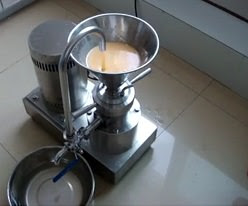Colloidal Mill is used to reduce the particle size of a solid present in different liquid forms or solid forms of the pharmaceutical ingredients in pharmaceutical industry.
Colloidal Mill reduces the size of particles of solids that are suspended in a liquid, when a liquid suspended in another liquid, meaning that they are immiscible, this machine is used alternatively to reduce the size of droplet.
It is mainly reduce the solids which are present in the suspension or emulsion or the reduction in the suspension droplet size. It is almost used for the all types of materials for the reduction. The end result of this type of mix is very stable mix which is able to resist contamination by water or bleed. In fact this is the method used in mixing cement base grout. The colloidal mill uses a method known as shearing.
Basic parts
It consists of an inlet hopper which is used to feed the material into the mill.
It consists of a rotor and stator which are used to reduce the particles size by applying the shearing force.
It consists of an outlet which is used to discharge the reduced particles.
Construction
A colloidal mill consist of a high speed rotor and a stator with a conical milling surfaces between
Which is an adjustable clearance ranging from 0.002 to 0.03 inches.
The rotor speed is 3000 to 20000rpm. The material to be ground should be pre milled as finely as possible to prevent damage to the colloidal mill.
Rotors and the stator may be smooth surfaced or rough surface. With the rotor and the stator there is a thin uniform film of material between them and it is subjected to the maximum amount of shear.
Rough surfaced mill add intense eddy current, turbulence and the impaction of the particles to the shearing action.
Principle of Colloidal Mill
Colloidal mill works on the principle of rotor-stator.
The size reduction is affected due to shearing, when the material is passed between the narrow gap of milling surfaces of rotor and stator. A rotor turns at high speeds of 3000 – 20000rpm. The high levels of hydraulic shear applied to the process liquid disrupt structures in the fluid. The rotor and stator surface covered with metal toothed coverings which cut and shear the solid. Colloid mills are frequently used to increase the stability of suspensions, emulsions and can also be used to reduce the particle size of solids in suspensions.
Higher shear rates leads to smaller droplets of 1 micron. Based on a rotor rotating at high speed and very close to a conical stator, the particle size is done by modifying the gap between the rotor and the stator.
The resultant is then passed through to the discharge area. The drain pipe removes the final product from the colloidal mill. If the final product has not been sheared to the desired size, it can be re-circulated back to the machine for further shearing.
Working of the Colloidal Mill
The material is placed into the mill though the inlet hopper. It is then passed through the narrow gap between the rotor and stator and thus reduced the fine particle size. A colloid mill is a hydraulic shear producing device.
The colloid mill works to reduce the size of the suspended droplets. The mill allows the solid particles to become so small.
The process of colloid milling is done through the addition of the heavier liquid into the chamber of the mill that performs the shearing process. Once the heavier liquid has been added the lighter material whether it is a solid mass or a liquid of different viscosity is added to the material to start the mill. When the milling portion of the function takes place, the materials are both stirred together within the mill at a high rate of speed.
In other model the stator remains constant and the rotor will do the function of rotation. It creates the amount of hydraulic shear needed to break down the materials.

Working of colloidal mill
PHARMACEUTICAL APPLICATIONS
-
The main use of a colloid mill is the dispersion of solid particles within a liquid.
-
It is frequently used to increase the stability of suspensions and emulsions.
-
It is used for the formation of the efficient emulsification, homogenization, dispersion and mixing during the course of cutting, milling and shocking with high frequency.
-
It is used to reduce the particle size in suspension in a liquid or to reduce the droplet size of a liquid suspended in another liquid. By applying high levels of hydraulic shear to the process liquid the reduction is done.
-
Particles size of as small as 3 microns can be obtained by the colloidal mill.
-
Fibrous materials can be milled using rough surfaced rotor and stator.
-
It is mainly used in pharmaceutical purpose for the preparations colloidal dispersions, suspensions, emulsions and ointments.
-
Colloidal mill is utilized in a number of industries including, food and beverage, pharmaceuticals and chemicals.
-
Colloidal mill is ideal for small, medium and large scale tablet batching systems. The colloid mill is the most efficient system for dispersion and homogenization of raw material.1-6
-
Colloidal mill can be sterilized. So it can be mainly used in the production of the sterile products.
OTHER APPLICATIONS
-
It is also used in the liquid-to-latex emulsion process. Latex paints must be mixed with solid pigments or oil-based pigments to achieve certain colors.
-
Colloid mills are used in the following industries: Pharmaceutical, Cosmetic, Paint, Soap, Textile, Paper and Food.
-
Some of the products manufactured in colloidal mills include: Soybean milk, Fruit jam, Peanut butter, Artificial corn milk, Cream, Perfumery compound, Pigment, Greasing oil, Dyestuff, Fish liver oil, Pollen, Honey, Tooth – paste.
-
Colloid Mill offered is suitable for use in processing of paints, inks, coatings & construction chemicals.
ADVANTAGES
-
High throughput with excellent grinding result.
-
Suitable for products of high viscosity range.
-
High quality surface finishes for easy cleaning.
-
Capable of operation under pressures up to 16 bar.
-
Machine is self-draining.
-
Infinitely adjustable gap settings between rotor/stator for control of particle size reduction
-
High-value seal with wear-resistant materials.
-
Other materials and finishes are available upon request
-
Low noise levels.
DISADVANTAGES
-
Requires high power for the running of the colloidal mill.
-
Using of wet materials.
-
Consumes more energy.
REFERENCES
-
Lieberman, Herbert A, Lachman, Leon (2009), Industrial pharmacy: Pharmaceutical dosage form-milling. Banglore, Pune. ISBN: 978-81-239-1679-8.
-
Mehta RM, Pharmaceutics-I: Size reduction (1996), Page no: 117-118.
-
http://www.answers.com/topic/colloid-mill#ixzz32v0sSPLt
-
http://en.wikipedia.org/wiki/Colloid_mill
-
http://www.answers.com/topic/colloid-mil
-
http://www.chemineer.com/en/products/greerco/colloid-mill.html










